The German automaker is introducing the latest iteration of the iconic Microbus, this time through a concept named the Volkswagen Bulli.
Set to ge unveiled today in Geneva, the Volkswagen Bulli is a 6-seater (3+3) compact people carrier, with power provided by a 40 kW lithium ion battery positioned under the floor, behind the sills which is linked to a 85 kW ( 115 PS/ 192 lb-ft / 260 Nm of torque) electric motor. This powertrain configuration enables the Volkswagen Bulli to return a theoretical range of 186 miles (300 Km), and accelerate from 0 to 62 mph (0 to 100 Km/h) in 11.5 seconds.
Measuring 3.99 in length, 1.75 m in width, 1,70 m height and with a 2.62 m wheelbase, the new Bulli is slightly longer than a Golf, weights 1,450 Kg ad can reach a top speed of 87 mph (140 Km/h).
Just like the original Samba, the Volkswagen Bulli Concept features a two tone paint scheme, with 18 inch alloys, and an over-sized ‘V’ on the bonnet. Cargo capacity is 370 litres or 1,600 litres with the rear seats folded.
Some of the latest gadgets inside the Volkswagen Bulli Concept include a removable iPad in the centre console, which serves as a multifunctional touchscreen, media centre for Internet based applications and can also handle navigation functions, and due to the fact that there is no combustion engine, the car does not have a centre console, nor a gear lever.
Even though the Volkswagen Bulli is an electric concept, the automaker says it can also accommodate their fuel efficient petrol and diesel direct injection engines.
Volkswagen press release :
â–º Latest evolution of iconic Microbus brings new ‘Bulli’ concept to Geneva Motor Show
â–º Six-seater (3+3 configuration) gives maximum flexibility within compact bodystyle
â–º Powered by lithium-ion battery supplying an 85 kW electric motor
â–º Show concept with two-tone paint echoes design features of original Samba bus
* All-new ‘Bulli’ concept makes world debut at Geneva Motor Show, a development of the Microbus from 2001 and a new generation of Volkswagen people carrier
* More compact than the earlier concept vehicle, it is powered by an electric motor and fitted with six seats and infotainment control via iPad. It is front-engined and front-wheel drive
* New Bulli measures 3.99 m in length, 1.75 m in width and 1.70 m in height. Wheelbase is 2.62 metres, slightly longer than that of a Golf (2.58 m). Bulli also has a wide track (1.50 m front and rear) in relation to its body width. Front and rear overhangs are very short.
Kerb weight is 1,450 kg
* Energy is supplied by a 40 kWh lithium-ion battery concealed in the sandwiched floor behind the sills which powers the Bulli’s electric motor
* This engine produces 85 kW of power and 260 Newton metres of torque (115 PS/192 lbs ft). Theoretical driving range is up to 300 km (186 miles) – a high value for an electric car
* The new Bulli can accelerate from zero to 100 km/h (62 mph) in 11.5 seconds, and has a top speed (electronically limited) of 140 km/h (87 mph)
* Concept can also accommodate Volkswagen’s efficient petrol and diesel direct injection engines
* Like the original Samba bus, the Bulli presented in Geneva has two-tone paint and a distinctive ‘V’ on the bonnet; 18-inch alloy wheels are distinctive with stylised chrome hubcaps – another tribute to the Samba bus
* Bulli has six seats: three on a front bench seat (which can be folded) and three on the rear bench which can be folded flat to maximise loadspace
* When all six seating locations are occupied, a 370 litre loadspace is available; with seats folded, the cargo capacity of the 1.8 metre long interior increases to 1,600 litres
* A removable iPad in the centre console serves as a multifunctional touchscreen. Along with Internet-based applications and the media centre, it also handles phone and navigation functions
* There is no tachometer (unnecessary with an electric motor) nor a centre console, nor gear lever. The latter is replaced by a rotary switch to the right of the driver, which is used to select forward and reverse gears. A push button in the same switch is used to activate and switch off the motor. Another rotary switch to the left of the driver is used to control the lighting functions
* Original design of the Volkswagen bus comes from that of Dutch Volkswagen importer Ben Pon. On 23 April 1947 Pon sketched a compact bus – a simple side view of a radically shortened public omnibus placed over the wheelbase of a Beetle with an ‘m’ for ‘motor’ written on it. This became the basis for the original Transporter or T1 which was launched in 1950.
Volkswagen has unveiled an all-new concept, the ‘Bulli’, at the Geneva Motor Show. It is a development of the Microbus concept which made its debut ten years ago in 2001 and a new generation of Volkswagen people carrier – the first of which broke cover back in 1950 with the production of the first Transporter.
More compact than the 2001 concept vehicle, the new Bulli is powered by an electric motor and fitted with six seats and infotainment control via iPad. It is front-engined and front-wheel drive. On a wheelbase measuring 2.62 metres – slightly longer than that of a Golf (2.58 m) – the new Bulli measures 3.99 m in length, 1.75 m in width and 1.70 m in height. In relation to its width it has a wide track (1.50 m front and rear), and very short overhangs at the front and back. Its kerb weight is 1,450 kg.
This includes the weight of the energy source: a 40 kWh lithium-ion battery, which is concealed in the sandwiched floor behind the sills and powers the Bulli’s electric motor. This engine produces 85 kW (115 PS) of power and 260 Nm (192 lbs ft) of torque and the theoretical driving range is up to 300 km (186 miles) – a high value for an electric car. With this electric motor, the new Bulli can accelerate from zero to 62 mph in 11.5 seconds and go on to an electronically limited top speed of 87 mph. The concept could also accommodate, as an alternative power source, one of Volkswagen’s efficient petrol and diesel direct injection engines.
Like the original Samba bus, the Bulli presented in Geneva has two-tone paint and a distinctive ‘V’ on the bonnet; its 18-inch alloy wheels with stylised chrome hubcaps are another tribute to the Samba bus.
Inside the Bulli has six seats: three on a front bench seat (which can be split and folded) and three on the rear bench which can be folded flat to maximise loadspace – or turn into a bed in the true spirit of the iconic campervan. When all six seating locations are occupied, a 370 litre loadspace is available; with seats folded, the cargo capacity of the 1.8 metre long interior increases to 1,600 litres.
A removable iPad in the centre console serves as a multifunctional touchscreen. Along with Internet-based applications and the media centre, it also handles phone and navigation functions. There is no tachometer (unnecessary with an electric motor) nor a centre console, nor gear lever. The latter is replaced by a rotary switch to the right of the driver, which is used to select forward and reverse gears. A push button in the same switch is used to activate and switch off the motor. Another rotary switch to the left of the driver is used to control the lighting functions.
Such hi-tech equipment is of course a far cry from the original Volkswagen bus, the design for which came from that of Dutch Volkswagen importer Ben Pon. On 23 April 1947, Pon sketched a compact bus – a simple side view of a radically shortened public omnibus placed over the wheelbase of a Beetle with an ‘m’ for ‘motor’ written on it. This was to become the basis for the original Transporter or T1 which was launched in 1950 – and is still popular to this day.
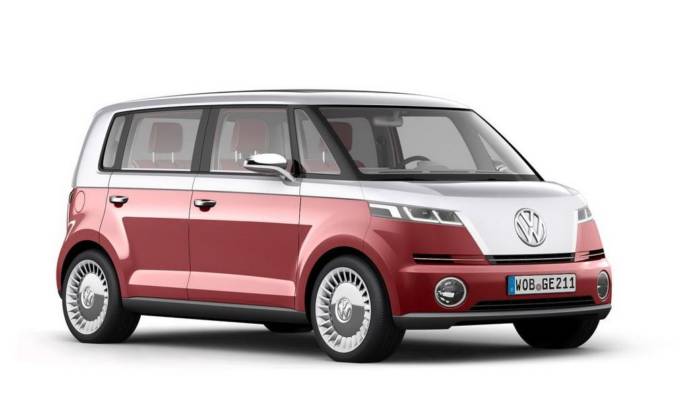
28 Feb 2011
2
Volkswagen Bulli Concept
2 Comments
Comments are closed.

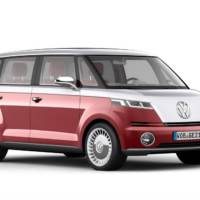

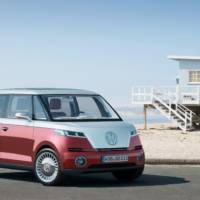
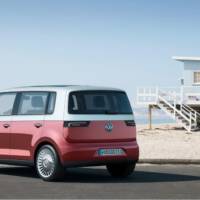
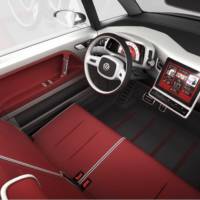
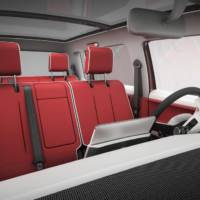
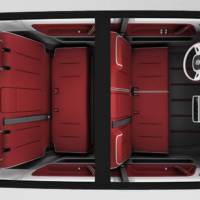
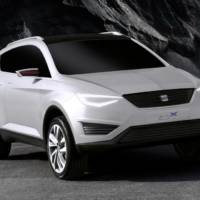
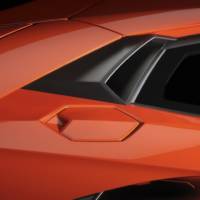
Whats the price ??
there’s no price, this is a concept car